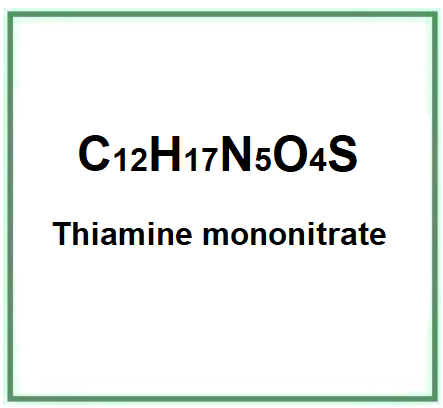Thiamine nitrate is a chemical compound, a synthetic nitrate and stabilized form of vitamin B1, also known as thiamine.
Description of raw materials used in production.
- Raw materials for the synthesis of thiamine can include pyrrole and thiazole derivatives. These compounds are subsequently joined and modified to produce thiamine, which can then be nitrated to produce thiamine mononitrate.
Step-by-step summary of the industrial chemical synthesis process.
- The pyrrole core is synthesized.
- Separately, the thiazole core is synthesized.
- These two cores are joined together via a condensation reaction.
- The resulting thiamine can undergo nitration to produce thiamine mononitrate.
Thiamine mononitrate typically appears as a white crystalline powder, water-soluble and is typically odorless.

Medical
Vitamin B1 Deficiency Treatment. Used to prevent and treat thiamin deficiencies, which can lead to conditions like beriberi and Wernicke-Korsakoff syndrome.
Nutritional Therapy. It's often a part of IV vitamin formulations used in hospitals for malnourished or malabsorbing patients.
Food
Thiamin mononitrate is often used as a food additive to fortify products with vitamin B1. Found in cereals, bread, flour-based products, and supplements.
Dietary Supplements. It's a common form of vitamin B1 in vitamin supplements.
Cosmetics
Skin conditioning agent. It is the mainstay of topical skin treatment as it has the function of restoring, increasing or improving skin tolerance to external factors, including melanocyte tolerance. The most important function of the conditioning agent is to prevent skin dehydration, but the subject is rather complex and involves emollients and humectants that can be added in the formulation.
Other Applications
Biomedical Research. Research continues on the effects of vitamin B1 on the body and potential new therapeutic applications for thiamin mononitrate.
- Molecular Formula C12H17N5O4S
- Molecular Weight 327.36 g/mol
- CAS 532-43-4
- UNII 8K0I04919X
- EC Number 208-537-4
- DTXSID4038762
- Metabolomics Workbench ID 45081
- NCI C87669
- RXCUI 10456
Synonyms:
Thiamine Mononitrate
Bibliografia_____________________________________________________________________
(1) Wilson, R. B. (2020). Pathophysiology, prevention, and treatment of beriberi after gastric surgery. Nutrition Reviews, 78(12), 1015-1029.
Abstract. Beriberi is a nutritional complication of gastric surgery, caused by deficiency of vitamin B1, or thiamine. Thiamine deficiency leads to impaired glucose metabolism, decreased delivery of oxygen by red blood cells, cardiac dysfunction, failure of neurotransmission, and neuronal death. This review describes the history and pathophysiology of beriberi as well as the relationship between beriberi and nutritional deficiencies after gastric surgery. A literature review of the history and pathophysiology of beriberi and the risk factors for thiamine deficiency, particularly after gastric resection or bariatric surgery, was performed. Recommendations for nutritional follow-up post gastric surgery are based on current national guidelines. Patients may have subclinical thiamine deficiency after upper gastrointestinal surgery, and thus beriberi may be precipitated by acute illness such as sepsis or poor dietary intake. This may occur very soon or many years after gastrectomy or bariatric surgery, even in apparently well-nourished patients. Prompt recognition and administration of supplemental thiamine can decrease morbidity and mortality in patients with beriberi. Dietary education post surgery and long-term follow-up to determine nutritional status, including vitamin and mineral assessment, is recommended for patients who undergo gastric surgery.
(2) Whitfield, K. C., Smith, T. J., Rohner, F., Wieringa, F. T., & Green, T. J. (2021). Thiamine fortification strategies in low‐and middle‐income settings: a review. Annals of the New York Academy of Sciences, 1498(1), 29-45.
Abstract. Thiamine (vitamin B1) is an essential micronutrient in energy metabolism and cognitive and neurological health. Thiamine deficiency disorders (TDDs) have a range of clinical presentations that result in various morbidities and can be fatal if not promptly recognized and treated, especially in infants. To intervene, thiamine intakes by breastfeeding mothers and others at risk of thiamine deficiency should be increased to ensure adequate thiamine intake. Although thiamine fortification programs have a long history in high-income countries, there are few mandatory fortification programs to address TDDs in low- and middle-income countries (LMICs), particularly in the regions of greatest concern, South and Southeast Asia. This review highlights essential aspects for consideration in the development of a mandatory fortification program in LMICs, including an overview of the data required to model fortification dosing schemes, available thiamine fortificants, and potential fortification vehicles, as well as identifies current knowledge gaps.
![]() Thiamine nitrate
Thiamine nitrate 



